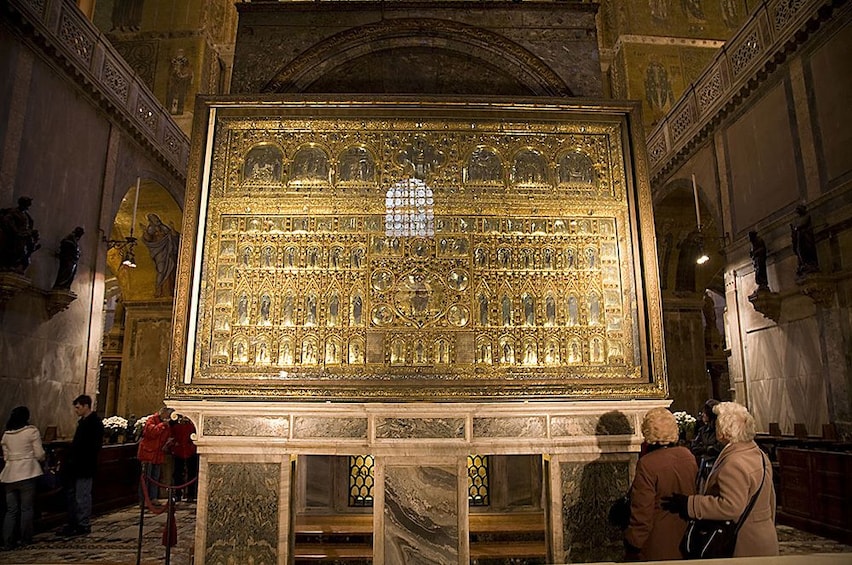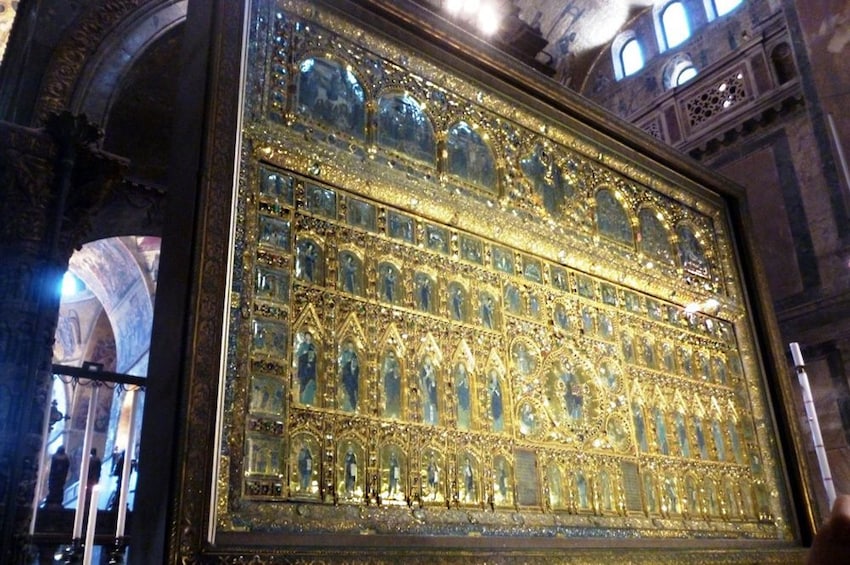La Pala d'oro nella Basilica di San Marco a Venezia Icona Immagine di Dio

Detail of the Pala d'Oro, St. Mark's Basilica, Venice (1) Flickr
The Pala d'Oro is a Byzantine alter piece that is covered in gold and studded with almost 2,000 gems. St. Mark's Basilica. Things to Do at St. Mark's Basilica. A visit to St. Mark's Basilica is more than just entering the cathedral and gazing up at the golden mosaics. You can see the Pala d'Oro, visit the tombs beneath the.

Pala d'Oro in bezoeken? Nu tickets boeken!
Duration: about 2 hours. Operative according to the Basilica calendar. Languages: English. Children 0-5 years are free of charge. Entrance ticket to St. Mark's Basilica and Pala d'Oro s is included. We reccomend to wear appropriate clothes for a place of worship. Change your voucher into a regular ticket at the meeting point.

X.XIVs.Pala d'Oro,a high altar retable of the Basilica di San Marco,Venice.Byzantine enamel.The
Historical significance: The Pala d'Oro dates back to 916 AD, and is a topic of debate between the spiritual and aesthetic.; Exquisite craftsmanship: The altarpiece (3.34 m long and 2.12 high) was built by Constantinople craftsmen in wood, gold, silver, precious stones, and cloisonné enamel.; Enamelwork: On a gold background, in combination with the enamel technique, the precious stones evoke.
La Pala d'oro nella Basilica di San Marco a Venezia Icona Immagine di Dio
Pala d'Oro (Italian, "Golden Pall" or "Golden Cloth") is the high altar retable of the Basilica di San Marco in Venice. It is universally recognized as one o.

Venice, Pala d'Oro a photo on Flickriver
It is a wooden frame about 2 meters (6 and a half feet) high and 3.30 meters (11 feet) wide, coated with silverplates and entirely covered with 24 carat gold leaf. It hosts 255 enamel plates and medallions, surrounded by 1297 precious and semi-precious stones (pearls, emeralds, rubies, sapphires, amethysts…), which enhance the beauty and the.

Pala d’Oro (Italian, "Golden Pall" or "Golden Cloth") is the high altar retable of the Basilica
The Pala d'Oro (the altar retable) has remained in its original position behind the high altar. It is an altar piece with about 250 cloisonn� enamels of different sizes and epochs (10th - 12th century) on sheet gold. It was commissioned in Byzantium by the Venetians. In the lower panel, above the great Christ Pantocrator in the centre there are evangelists, prophets, apostles and angels.

Best Venice Guides Venice and its jewels the Golden Altarpiece Pala d’Oro
The Pala d'Oro is adorned with precious stones, pearls, and enamel, and is composed of 12 sections or plaques, which represent different scenes from the life of Jesus Christ and the Virgin Mary. The centerpiece of the altarpiece is an image of the Madonna and Child, surrounded by twelve enamel medallions, each representing an apostle.

detail of the pala d'oro, san marco, venice Возрождение искусства, Эмали, Римская империя
Other articles where Pala d'Oro is discussed: enamelwork: Byzantine:.is the altar screen "Pala d'Oro" in St. Mark's, Venice, believed to have been brought from Constantinople to Venice about 1105. The quality of Byzantine enamelling began to decline in the late 12th century.

Pala d'oro, basilica de san marco, Venecia, Italia Basilica de san marcos, Ilustración del
The Pala d'Oro ticket allowed access not only to the magnificent altarpiece but also got us much closer to the high altar tomb of St. Mark. Likewise, the museum ticket enabled us to see the glorious mosaics from a higher vantage point with a commanding view of the entire Basilica. We also could go outdoors and see St. Mark's Square.

San Marco, Basilica & Pala D'oro Walking Tour
Pala d'Oro. Behind the main altar you can admire the Pala d'Oro, the only example in the world of considerably sized, intact Gothic goldsmithing. This refined work of Byzantine enamel - measuring 3.34 meters wide and 2.12 meters high - is divided into two main parts, one lower and one upper. The altar is composed of about 250 cloisonnés.

San Marco, Basilica & Pala D'oro Walking Tour
The Pala d'Oro, or Golden Cloth, is a stunning altar retable in St. Mark's Basilica in Venice. In Latin, the word pala means cloth, hence the name. The Doge Pietro Orseolo commissioned it in 976 AD. He asked some artisans to create a special item made of precious stones and enamel depicting various saints. That's how the Pala d'Oro came.

La Pala d'oro nella Basilica di San Marco a Venezia Icona Immagine di Dio
Pala d'Oro: Our most recommended tours and activities. 1. Venice: St. Mark's Basilica Fast-Track Entry and Audio Guide. Save time during your visit to Venice with a skip-the-line ticket to the popular St. Mark's Basilica. Admire the hundreds of golden mosaics in the Basilica and learn details about the byzantine art inside with your audio.

Icona Immagine di Dio La Pala d'oro nella Basilica di San Marco a Venezia
Pala Hotel Deals on Agoda. Read Million of Genuine Reviews of Your Dream Spa Resort! We're Available Live 24/7 to Help. Don't Get Stranded When Traveling!

Venice and its jewels the Golden Altarpiece Pala d’Oro Best Venice Guides
Book your Hotel in Palidoro online. No reservation costs. Great rates. Find What You Need At Booking.Com, The Biggest Travel Site In The World.

X.XIVs.Byzantine enamel. Pala d'Oro, detail. altar retable of the Basilica di San Marco, Venice
The Pala d'Oro. Concealed behind the high altar, this sumptuously refined piece of goldwork (3.34 m long and 2.12 high) was commissioned from Constantinople craftsmen in 916, when the city was the gateway between East and West. It is made of wood, gold, silver, precious stones and cloisonné enamel. During the main religious festivals, it is.

Pala d'Oro one of the finest treasures in Venice Cristiano, Eiffel Tower Inside, Louvre
The Pala d'Oro incorporates over eighty Byzantine enamels dating from the tenth to the late twelfth century—a period of flourishing in Byzantine enamel work—as well as later Venetian enamels. The techniques used in these cloisonné enamels revived those from antiquity: Powdered glass (frit) is placed into metal compartments ( cloisons ) and heated so that it bonds with its metal frame.